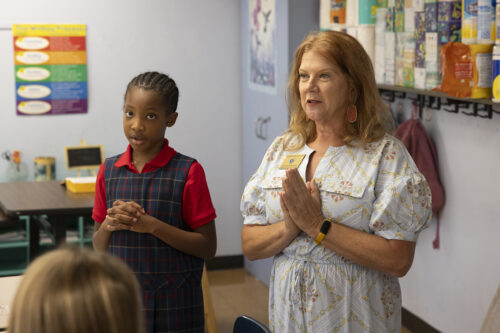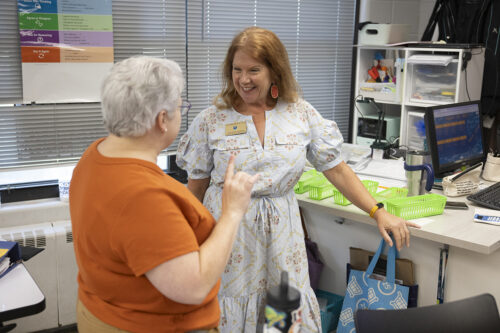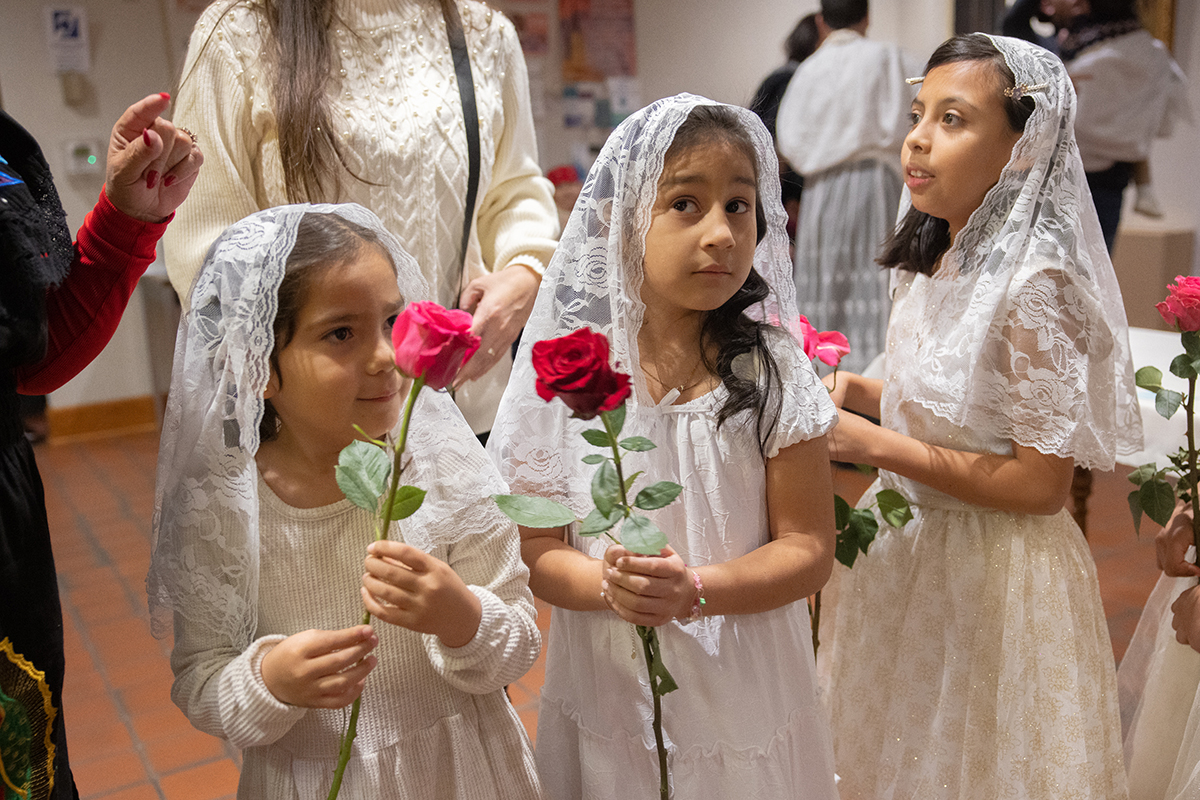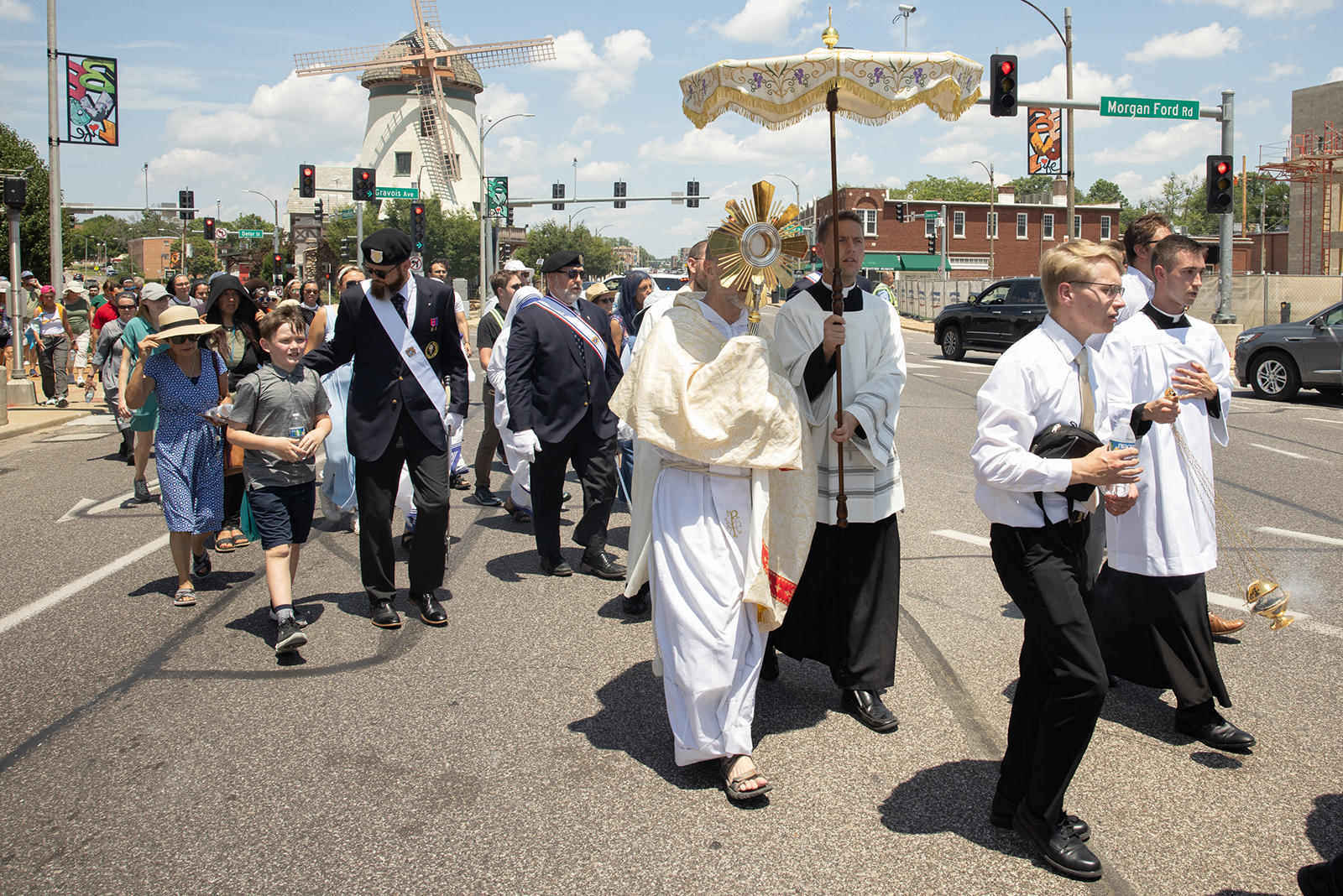New president of Catholic education embraces mission of evangelization with joy

Julie Scott Soffner assumed the newly created role in July
On a late August morning at St. Francis of Assisi School in Oakville, Julie Scott Soffner slipped into a bustling fourth grade classroom. She was ready to learn.
St. Francis’ fourth grade class has 36 students this year, an example of the variation in class sizes that has required some creative use of space and staff, principal Beth Bartolotta explained to Soffner. The school knocked down a handful of adjoining classroom walls, replacing them with sliding barn doors to create flexible room sizes for smaller or larger classes or groupings. That morning, the doors were open, and teachers walked among small groups of students reading quietly or having guided discussions.
Over the next hour and a half, Bartolotta and Soffner visited every grade on a school tour. Soffner admired the preschoolers’ letter pages, listened to sixth grade girls explain their first group project in the STEM-based Project Lead the Way course, and prayed with a class exploring the parable of the vine and the branches in the Catechesis of the Good Shepherd atrium.

In the middle school hallway, they walked by a sign on the wall with a simple question: How are we evangelizing?
As the new president of the archdiocesan Office of Catholic Education and Formation, that’s exactly what Soffner is exploring. Since assuming her role on July 1, she’s spent as much time as possible visiting schools around the archdiocese to learn about their communities, charisms, strengths and challenges.
“We have a saying: If you’ve seen one Catholic school, you’ve seen one Catholic school,” Soffner said.
As president — a new position in the education office created by Archbishop Mitchell T. Rozanski — Soffner sees herself not as a know-it-all but a “learn-it-all,” she said. She’s spending her first few months getting to know the experts already in place in the education office and out in the schools, building on relationships she formed over the past three years as the executive director of the Today and Tomorrow Educational Foundation. She also looks forward to applying her decades of business experience from her career in management at Enterprise, where she worked for 34 years before joining TTEF.
There are certainly many challenges facing Catholic schools right now, Soffner said. Financially, schools are working to balance the rising cost-to-educate with the need to increase teacher pay — and also keep tuition as affordable as possible for families. Looking at new, creative revenue streams will be important, she added.
Shifting demographics have contributed to enrollment booms and slumps in different areas, so the team is continuing to take a hard look at the data: Where are families with young children settling down? What education options do families have? If families are not choosing a Catholic school, why not? If non-Catholic families attend a Catholic school, how are we meeting them where they are in order to invite them deeper?
These are not necessarily new challenges, Soffner said, but she sees an opportunity to explore new solutions with evangelization at the center of the conversation. Catholic education is a crucial piece of Archbishop Rozanski’s “Disciples Make Disciples” vision for the archdiocese, she said, with rich opportunities for new ardor, new methods and new expression.

To start with, “New ardor? You’ve never met anyone who has more excitement and fire than a teacher, a principal, an education donor,” she said.
As she travels the archdiocese, she’s witnessing new methods and expression in action, like the adaptable learning configurations and community partnerships at St. Francis of Assisi. She recently attended an all-school Mass at Cardinal Ritter College Prep in St. Louis and met with president Tamiko Armstead, learning that the school received nearly three times the number of applications as spaces in their freshman class.
Nearby, St. Louis Catholic Academy kicked off its year in a new campus in the Carr Square neighborhood of St. Louis, welcoming 192 students in grades K-8, with a waiting list.
“We have grown by 70 students simply by moving the school to north Jefferson — not abandoning north city by any means, but by doing the right thing for the students, getting them 4 miles up the street into a beautiful building,” Soffner said. “And now we have a student body with 70 new students, growth and vitality right there in the city…We could talk west (region) all day long, but we’ve also got to talk about the growth and vitality in the city.”
The new vicariate structure in the archdiocese, which includes an education liaison for each of the three vicariates, has helped the education office form closer relationships with pastors and school communities, she said. And as the education team looks forward, Soffner is not afraid to dive into big-picture questions like school governance structure and opportunities for shared resources, exploring how doing things differently could help school communities make more disciples.
One more title Soffner is embracing? Team cheerleader.
“Can joy be a strategy for leading our school system? I believe so, and I believe so because at the core of ‘Disciples Make Disciples’ is joy, energy, excitement, new innovation and joyful experiences and expressions,” she said. “I’m going to try joy as a strategy.”
Julie Scott Soffner assumed the newly created role in July
Subscribe to Read All St. Louis Review Stories
All readers receive 5 stories to read free per month. After that, readers will need to be logged in.
If you are currently receive the St. Louis Review at your home or office, please send your name and address (and subscriber id if you know it) to subscriptions@stlouisreview.com to get your login information.
If you are not currently a subscriber to the St. Louis Review, please contact subscriptions@stlouisreview.com for information on how to subscribe.





